
Units of AAZP
Butterfly Park
It is one of the enclosures of the approved master lay-out plan of Arignar Anna Zoological Park, Vandalur, Chennai.
Butterfly parks in Zoological parks serve as window through which visitors watch nature and get inspired to become conservationists and future custodians of nature. The butterflies are important pollinators of several wild and domesticated plants and depletion of their population could adversely affect the regeneration of the plants. Considering the role of butterflies in maintaining nature’s ecological balance, a butterfly park has been established in Arignar Anna Zoological Park, Vandalur, Chennai with assistance from Tourism and Culture Department, Government of Tamil Nadu and Ministry of Tourism, Government of India at the cost of Rs.400 lakhs.
Butterfly park with nectar and host plant gardens and indoor conservatory has been established over an area of well fenced 2.7 hectares. An indoor conservatory in a shape of caterpillar to the size of 60 m length, 26 m width and height of 6 m has been constructed with roof of white poly carbonate sheet to allow natural sun light passed on to the ground. A predator insect proof stainless steel mesh has been provided all around the structure. A double door system has been provided to prevent the escape of the butterflies. Nectar and host plant gardens have been provided outside the indoor conservatory to supply breeding materials to the indoor conservatory. The following are the salient features of the butterfly park at Arignar Anna Zoological Park, Vandalur, Chennai:
Frontage of butterfly park
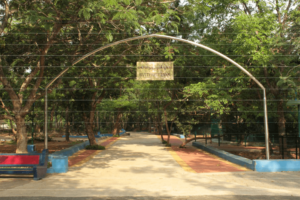
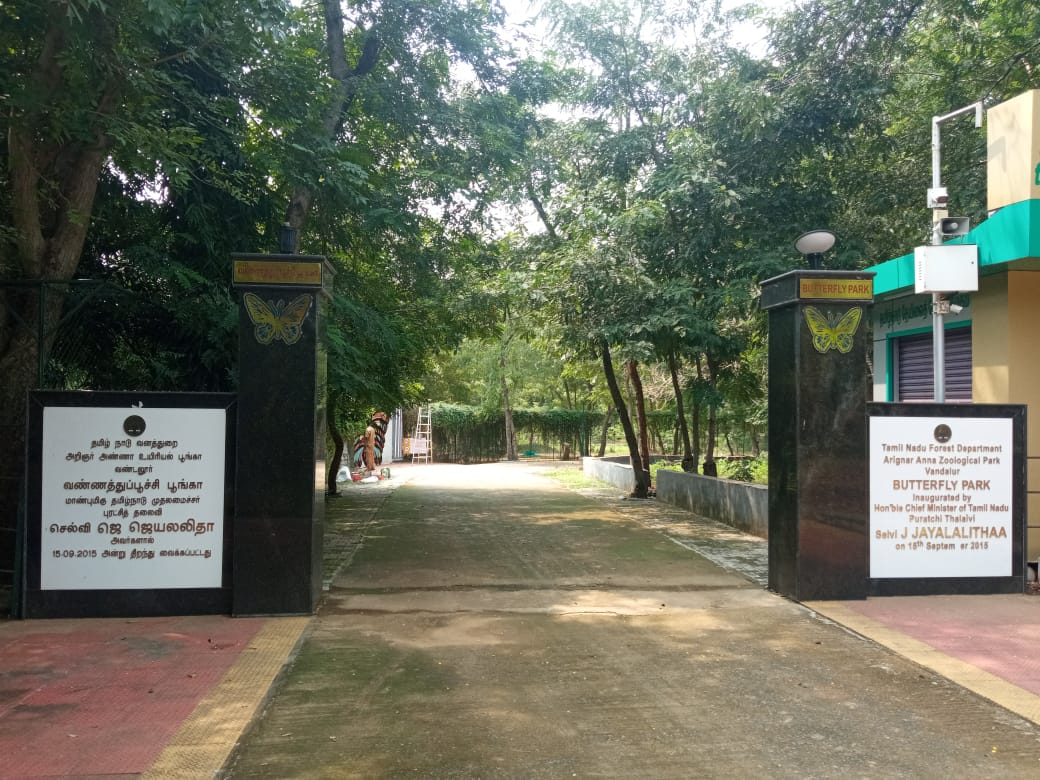
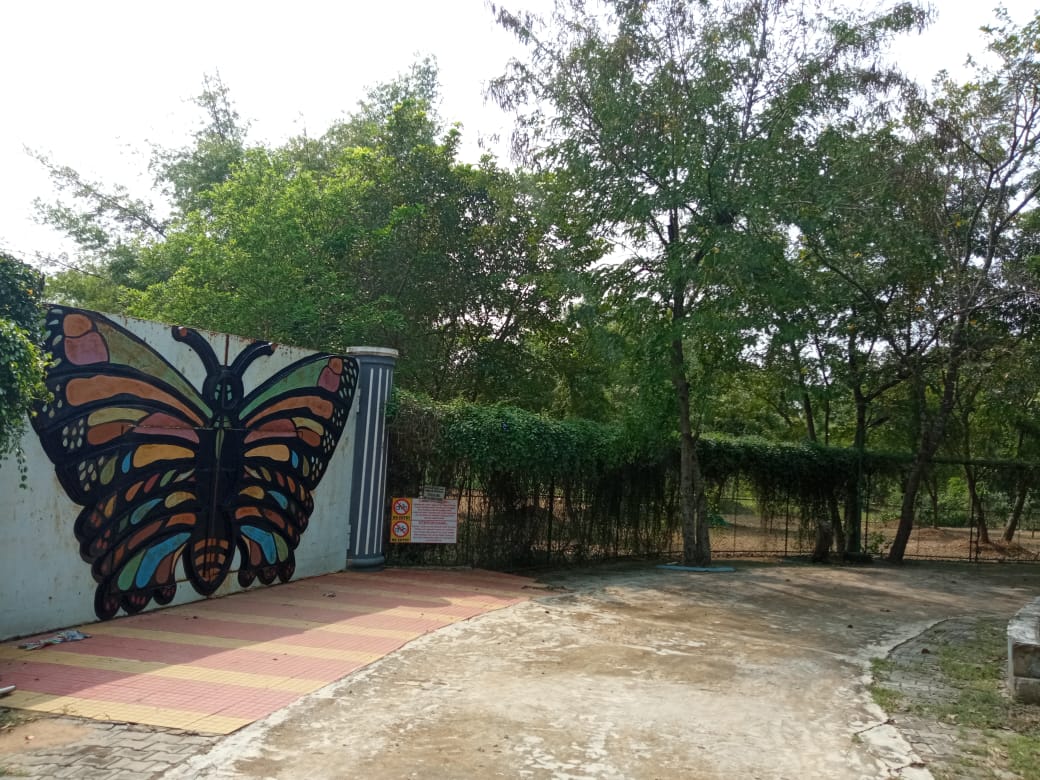
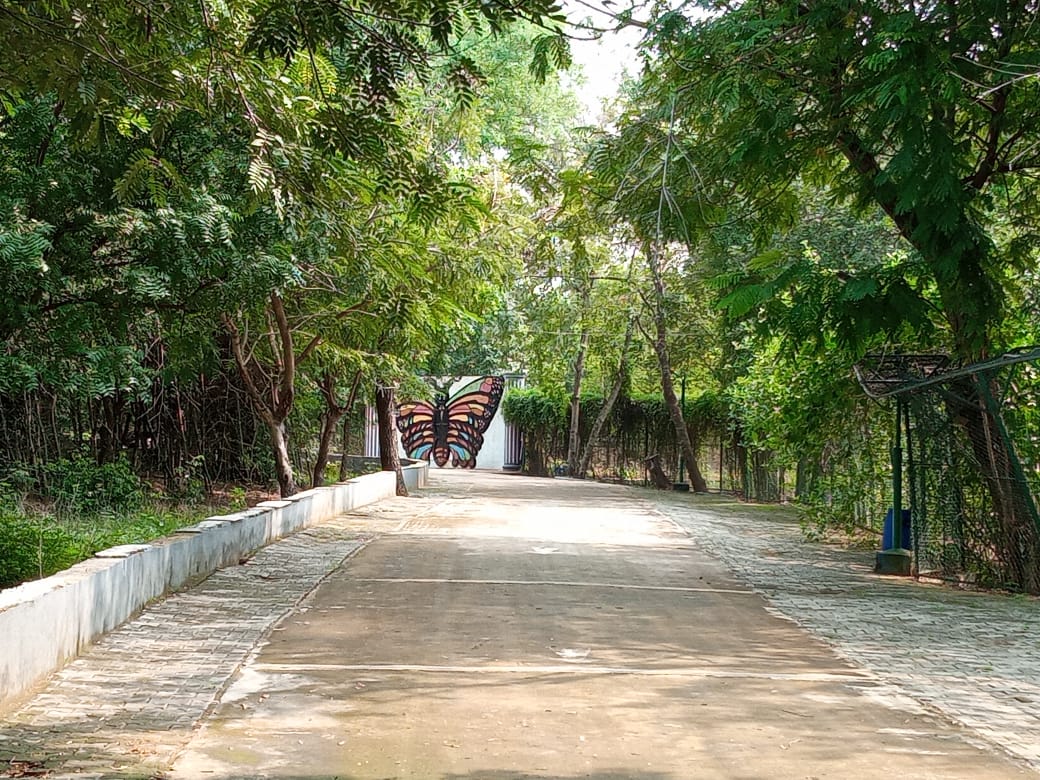
Arignar Anna Zoological Park, Vandalur attracts annually 2.4 million visitors. There are circular road and loop roads inside the Zoo for the internal movement of visitors. In order to facilitate and to guide visitors to visit the butterfly park, a prominent welcome arch with signage has been erected on circular road. The road from circular road up to the butterfly park has been improved with anti-skid tiles, lighting and tree lining. Xerophyte plants have been planted around the trees on the road leading to the butterfly park. Suitable toe walls have been constructed on road sides to conserve water while simultaneously acting as sitting benches to the visitors.
Butterfly indoor conservatory
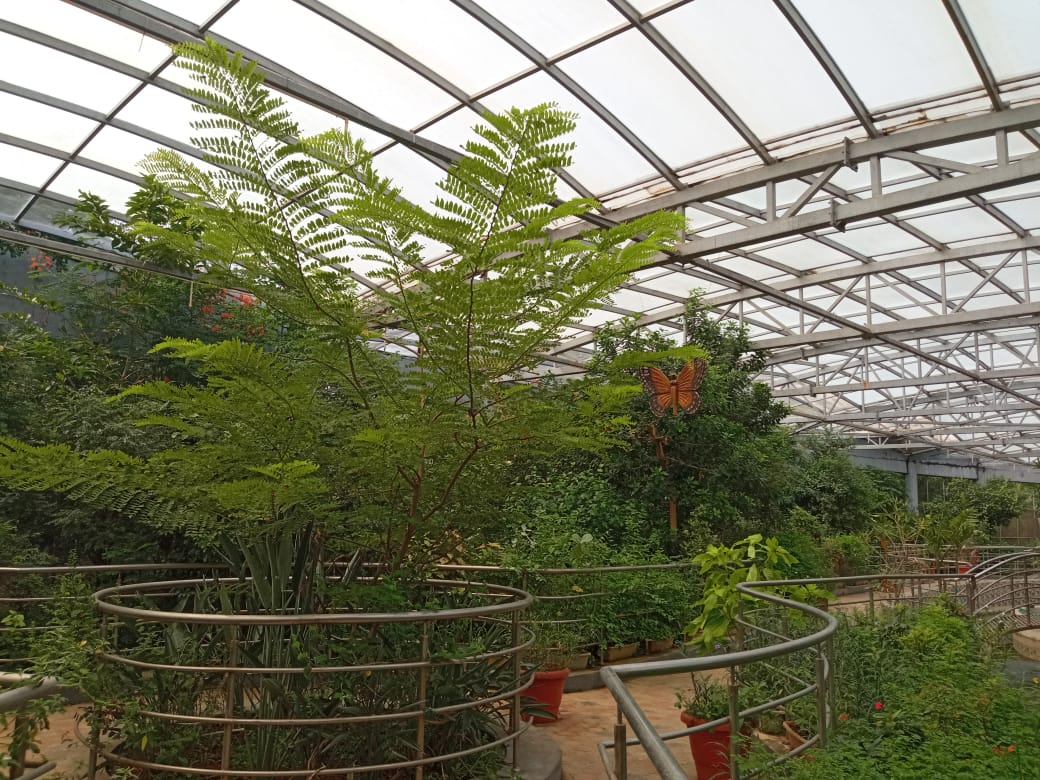
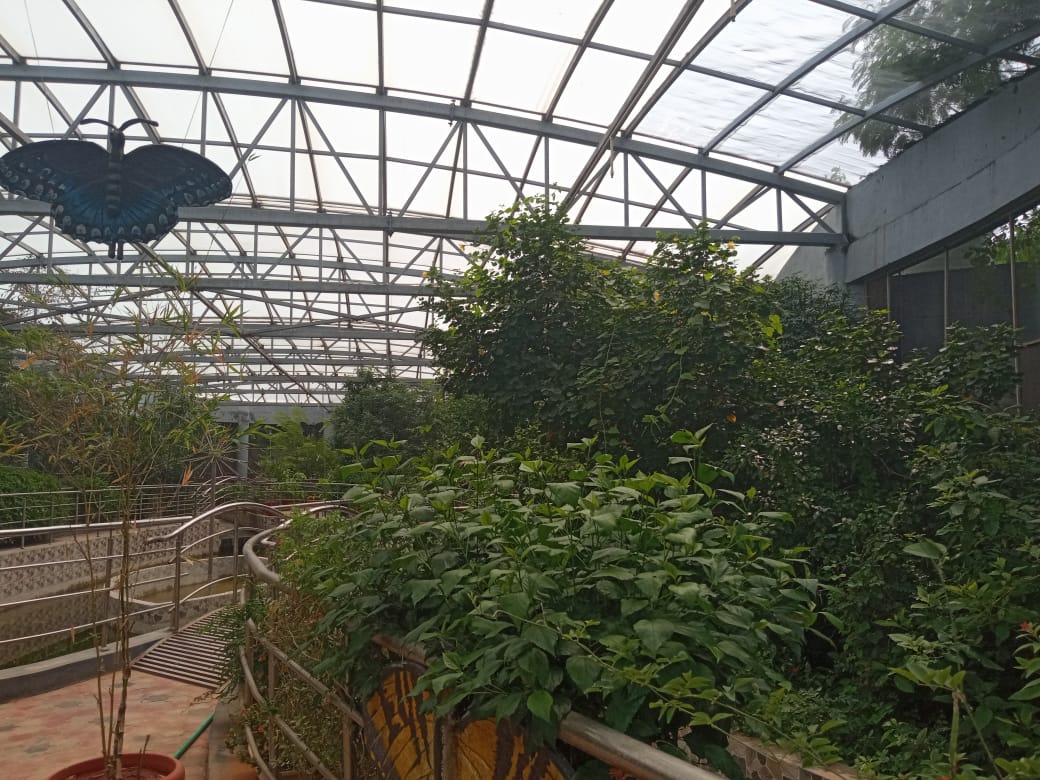
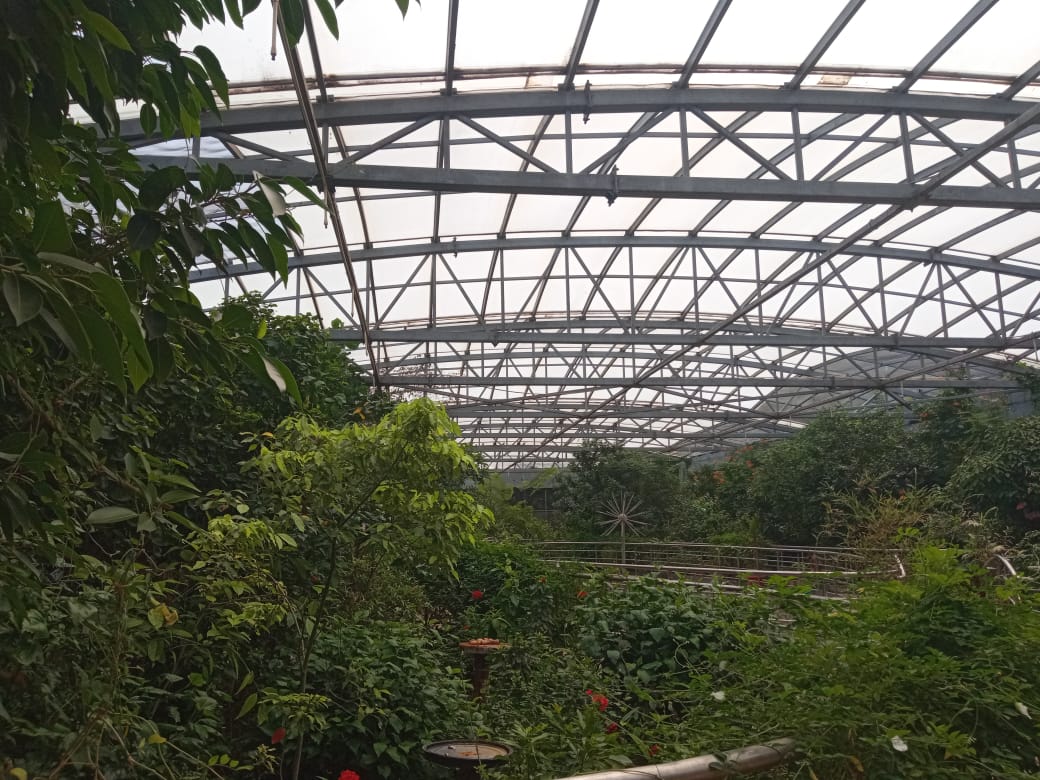

An indoor conservatory in a shape of caterpillar to the size of 60 m length, 26 m width and height of 6 m has been constructed with roof of white poly carbonate sheet to allow natural sun light passed on to the ground. A predator insect proof stainless steel mesh has been provided all around the structure. A double door system has been provided to prevent the escape of the butterflies. Shallow water channels and evaporation pond created inside will keep the humidity at desired levels. Eight islands have been created with red earth and suitable nectar and host plants have been planted with irrigation systems. To accommodate feeding and breeding requirements, climbers in pots and trays have also been provided to utilize the available space in an efficient manner. A photo gallery, larval rearing lab and pupa rearing lab have also been established inside the indoor conservatory. The rearing facilities for eggs, larvae, pupae and adults have been provided in the two air conditioned laboratories inside indoor butterfly conservatory.
Enrichment by means of meandering water channels and natural water courses
Tropical butterflies require day temperatures of 23 – 25 degree C and 80-85 % relative humidity. A slight and intermittent air current stimulates flight in many butterflies thus increases the frequency of feeding, locating of mate and courtship behaviour. Hence artificial meandering water channels side by side with walk paths have been provided to ensure continuous flow of shallow water throughout the butterfly park including inside indoor conservatory. The shallow channels carrying a film of water will pour into a shallow evaporating pond inside the indoor butterfly conservatory which will raise the humidity levels on evaporation inside the house. The water is collected back into a tank and recirculated back to the artificial channels. A naturally available water course inside the park has been developed by properly embanking the edges to facilitate smooth flow of water, supporting butterfly friendly grasses like Typha angustata, Acanthus ilicifoleus, Cynodon dactylon, Oryza sativa etc planted inside the partitioned channel. The humidity levels inside the water course help in promoting the growth of butterflies.
Nectar and host plant gardens
Butterflies undergo complete metamorphosis during their life cycle i.e. egg, larva, pupa and adult. Butterflies on the head have antennae, compound eyes and the proboscis (haustellum). Butterflies with their compound eye structure can virtually see in all directions. While human beings can perceive colours ranging from red to indigo, butterflies can see further into violet and ultra violet range of the light spectrum. Hence there is a need for developing nectar gardens with wide diversity of inflorescence. Adult butterflies can feed only juicy material such as nectar, juice from fruits, sap exuding from the trees etc. with the help of proboscis situated on the ventral side of the head. The two nectar gardens and three host plant gardens have been planted with about 200 species consisting of trees, shrubs, herbs, climbers, grasses, palms and reeds.
Climber gardens
The nectar and host plants which are climbers in nature have been planted over the iron scaffoldings above the walk paths and channels to utilize the vertical space as well. Species like Petrea volublis, Thunbergia grandiflora, Bignonia venusta, Cleodendrum thompsoniae etc. have been planted. The climber species have also been trained around fencing.
Nectar and host plant nursery
Management of nectar and host plant gardens is a continuous activity. There are annuals and perennials among them. In order to ensure continuity of the plants especially the nectar ones, a permanent nursery with facilities of mist tent, attenuation chambers and other facilities has been created. Annuals are produced continuously for uninterrupted supply.
Micro Fogging and Weather Control Systems
All the nectar and host plant gardens, both inside and outside have been provided with sprinkler and drip irrigation systems. The sprinkler systems along with drip systems have been installed to water the plants uninterruptedly during swarming and other times. Sprinklers would wet the wings of butterflies during the swarming time, hence sprinkler system will not be used and drip system will be utilized during the swarming time. Thermo-hygro meters have been placed at different locations inside the house to monitor the temperature and humidity levels.
Visitors’ walk paths and rest sheds
Visitors are allowed from one side and to exit from other side. Both entry and exits are connected to a well laid cement road with facilities of tree lining and seating arrangements. Meandering walk paths, side by side with shallow water channels and three rest sheds would take care of visitors’ comforts. Stainless steel barricades have been provided to prevent visitors from entering the nectar and host plant gardens. Visitors are guided with suitable directional signages throughput the butterfly park.
Educative signages, photo gallery and interpretation
Suitable signage boards have been erected along the walk paths depicting the details of life history, ecological role, behaviour, butterfly gardening, butterfly watching, photographing butterflies etc. Photo gallery and interpretation centre containing LED images of butterflies of Tamil Nadu and display of butterfly related videos and photographs through professional digital display equipment have been arranged in the indoor butterfly conservatory. Brass inscribed boards, brass lettering for different facilities and labelling of nectar and host plant species have also been provided.
Walk Through Aviary
Opened in 2010 in the name of Bio Centre it is spread over 1.5 acres.
Being the Biggest in the Country within a Zoo. The facility features 15 Meter tall fences to facilitate the free flight of birds within the area.
It supports 22 tree and shrub species, fruit-bearing trees such as mango, pomegranate, guava, Sapota, Jamoon, Singapore cherry for fruit-eating birds. Zoo has a mud bath facility for the birds.
Spot Your Favorite Bird and we have Got More surprises for you.The aviary is home to about 200 birds of different species including Alexandrine parakeet, rose-ringed parakeet, blue rock pigeon, common myna, Indian koel, common babbler, white-browed bulbul, francolin, red-vented bulbul, red-whiskered bulbul, wagtail, pipit, orange-headed thrush, red-wattled lapwing, little brown dove and spotted dove.
We Hope You found your favourite, step down to visit soon To AAZP to enjoy them in Live. Surely pleasure to your eyes.
Forest Museum
|
Visiting Goal- Forest Museum Of AAZP, Before Exit. |
Location- |
|
Visitor Rating- 10 stars |
Visitor Review- Nature Lovers’ comfort Zone & delighted to spend more time in the Forest museum. |
The Government has sanctioned the establishment of a forest and wildlife museum at Arignar Anna Zoological Park, Vandalur at a cost of Rs.20 lakhs during 2013-14.
Sections of the herbarium, solarium, insectarium, portraits, soils, rocks, seeds, and artifacts, etc., have been established for display in the museum. Suitable arrangements have been made in such a manner that all the visitors will pass through the museum while exiting from the Zoo
Aquarium
Location;-
|
Visiting Goal- Get to witness the chirpy Rock and Rolling Of Fishes & witness 31 species. |
Map- |
|
Tourist experience Rating- 10 stars |
Tourist Review- Fish lovers go Frenzy,Awestruck after finding the rarest species.
|
The shark-modeled aquarium, with its entrance and exit points in the form of gills of the shark, is set amidst
The shark-modeled aquarium, with its entrance and exit points in the form of gills of the shark, is set amidst a pond and it houses 31 species of fresh-water fishes. The pond surrounding the aquarium too has different varieties of fish.
Frontage
|
Visiting Goal-Enjoying The facelift of Zoo Entrace. |
Map- |
|
Tourist Experience Rating- 10 Stars |
Tourist Experience Review- A selfie with friends & intrigued with the New look of our Zoo. |
The facelift of the Zoo entrance was completed and the refurbished entrance was inaugurated by the Honourable Chief Minister on 19-06-2012. Now, Arignar Anna Zoological Park, Vandalur has become an important landmark of Tamil Nadu with its dynamic Frontage entrance. During your next visit Spend a few minutes to enjoy the facelift of Our historical AAZP & don't forget to capture your best moments.
Zoo Souvenir shop
|
Visit Goal- Zoo Shopping |
Map |
|
Visitor Experience Rating-10/10 |
Visitor Feedback- Kids Go crazy for shopping. |
Arignar Anna Zoological Park has opened a Souvenir Shop for visitors to purchase different products like Animal Keychains, Animal Toys, T-shirts, Caps, etc., from 'The Zoo Shop'. The visitors can now take their memories of the Zoo and souvenirs from the shop. A different range of products that Attract Children, Students, and Visitors are available here.
Virtual Reality
|
Visiting Goal- 360” View of Jungle and Underwater marine show. |
Map- |
|
Tourist Experience Rating- 10/10 |
Top Review- A Must Hangout Spot that should never be missed, Good experience! |
Virtual Reality Show with 360` view of jungle safari and underwater marine show attracts a lot of Zoo Visitors and make their visit more memorable.
Children's Park
|
Visit Goal;- Children’s Fun Zone |
Map |
|
Tourist’s Experience Rating- 10/10 |
Tourist experience Review- We Didn’t Rate our Kids asked us to. |
Children’S Park – Play area in Arignar Anna Zoological Park which is a Kids friendly zone & where parents can take a breather after an exhausting day exploring wildlife and nature. With all amenities to ensure to keep Kids entertained with all safety measures, Why Not your Kids have their Day out Too?!!


